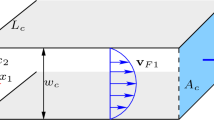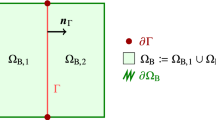Abstract
The paper studies the coupled diffusion-dissolution process in reactive porous media, separated by a fracture channel. An aggressive solute, corresponding for e.g., to a complete demineralization that dissolves the solid skeleton of the surrounding porous material, is prescribed at the inlet of the fracture. By means of asymptotic dimensional analysis it is shown that for large times the diffusion length in the fracture develops with the quadratic root of time. In comparison with the 1D-Stefan Problem, in which the dissolution front evolves with the square root of time, this indicates that the overall solute evacuation through the structure slows down in time. This phenomenon is referred to as a diffusive solute congestion in the fracture. This asymptotic behavior is confirmed by means of model-based simulation, and the relevant material parameters, related to only the chemical equilibrium condition, are identified. The obtained results suggest that the presence of a small crack does not significantly increase the propagation of the dissolution front in the porous bulk, and hence the overall chemical degradation of the porous material. The same applies to other diffusion induced demineralization, mineralization, sorption and melting processes, provided that the convective transport of the solute in the crack is small in comparison with the solute diffusion. The result is relevant for several problems in durability mechanics: calcium leaching of concrete in nuclear waste containment, mineralization and demineralization in bone remodeling, chloride penetration, etc.
Similar content being viewed by others
References
Barenblatt, G. I.: 1984, Dimensional Analysis. Gordon and Breach, New York.
Bažant, Z. P., Şener S. and Kim J. K.: 1986, Effect of cracking on drying permeability and diffusivity of concrete. ACI Materials J. 84, 351-357.
Bear, J.: 1991, Mathematical modelling of transport in porous media, in J. Bear and J.M. Buchlin, (eds), Modelling and Applications of Transport Phenomena in Porous Media. Kluwer Academic Publisher.
Carslaw, H. S. and Jaeger J. C.: 1959, Conduction of Heat in Solids, Second Edition. Oxford Science Publication.
Coussy, O.: 1995, Mechanics of Porous Continua, Wiley.
Cowin, S. C.: 1998, Bone fluid poroelasticity, in J.-F. Thimus et al. (eds), Proceedings of the Biot Conference on Poromechanics, Rotterdam, Netherlands, Balkema.
Crank, J.: 1957, The Mathematics of Diffusion. Oxford University Press.
Daïan, J.-F. and Saliba J.: 1993, Transient moisture transport in a cracked porous media, Transport in Porous Media, 13, 239-260.
Dormieux, L. and Lemarchand E.: 2000, A homogenization approach of advection and diffusion in cracked porous material. ASCE J. Engng Mech. to appear.
Eymard, R., Gallouít T. and Herbin R.: 2000, The finite volume method, in Ph. Ciarlet and J. L. Lions, eds, Handbook for Numerical Analysis, North Holland Publisher.
Fauchet, B., Coussy O., Carrére A. and Tardieu B.: 1991, Poroplastic analysis of concrete dams and their foundations. Dam Engng 2, 165-192.
GÉrard, B. and Marchand J.: 2000, Influence of cracking on the diffusion properties of cement-based materials. Part I: Influence of continuous cracks on the steady-state regime. Cement and Concrete Res. 30, 37-43.
Lee, Y.-M. and Kang C.-H.: 1999, Two-Dimensional nuclide decay chain transport in a fractured porous medium by a control volume approach, Ann. Nuclear Energy 26, 1569-1591.
Locoge, P., Massat M., Ollivier J.-P. and Richet C.: 1992, Ion diffusion in microcracked concrete, Cement and Concrete Res. 22, 431-438.
Logan, J. D., Ledder G. and Homp M. R.: 1998, A singular perturbation problem in fractured media with parallel diffusion. Mathematical Models and Methods in Appl. Sci. 8(4), 645-655.
Mainguy, M.: 1999, Modéles de diffusion non-linéaires en milieux poreux. Applications Àla dissolution et au séchage des matériaux cimentaires. PhD thesis, ENPC, France (in French).
Mainguy, M. and Coussy O.: 2000, Propagation fronts during calcium leaching and chloride penetration, ASCE J. Engng Mech. 126(3), 250-257.
Mainguy, M. and Eymard R.: 1999, Finite volumes for dissolution-diffusion equations, in: CD-Proc. 13th ASCE Engng Mech. Conf., Johns Hopkins University, Baltimore.
Martin, R. and Burr D.: 1989, Structure, Function and Adaption of Compact Bone, Raven Press, New York.
Moszkowicz, P., Pousin J. and Sanchez F.: 1996, Diffusion and dissolution in reactive porous medium: mathematical modelling and numerical simulations. J. Comp. Appl. Math. 66, 377-389.
Neretnieks, I.: 1980, Diffusion in the Rock Matrix: An Important Factor in Radionucleide Retardation? Water Resour. Res. 85(B8), 4379-4397.
Patankar, S. V.: 1980, Numerical Heat Transfer and Fluid Flow. Hemisphere Series on Computational Methods in Mechanics and Thermal Science, Hemisphere Publication.
Pawell, A. and Krannich K.-D.: 1996, Dissolution effects in transport in porous media, SIAM J. Appl. Math. 56(1), 89-118.
Schiessl, P. and Raupach M.: 1997, Laboratory studies and calculations on the influence of crack width on chloride-induced corrosion of steel in concrete, ACI Materials J. 94(1), 56-62.
Tang, D. H., Frind E. O. and Sudicky E. A.: 1981, Contaminant transport in fractured porous media: Analytical solution for a single fracture, Water Resour. Res. 17(3), 555-564.
Tognazzi, C.: 1998, Couplage fissuration-dégradation chimique dans les matériaux cimentaires: caractérisation et modélisation. PhD thesis, INSA Toulouse, France (in French).
Torrenti, J.-M., Didry O., Ollivier J.-P. and Plas F.: 1999, La dégradation des bétons. Couplage fissuration-dégradation chimique, Hermés, Paris (in French).
Travis C. C. and Etnier E. L.: 1981, A survey of sorption relationships for reactive solutes in soil, J. Environ. Quality 10(1), 8-17.
Van Duijn, C. J., Grundy R. E. and Dawson C. N.: 1997, Large time profiles in reactive solute transport, Transport in Porous Media 27, 57-84.
Author information
Authors and Affiliations
Rights and permissions
About this article
Cite this article
Mainguy, M., Ulm, FJ. Coupled Diffusion-Dissolution Around a Fracture Channel: The Solute Congestion Phenomenon. Transport in Porous Media 45, 479–495 (2001). https://doi.org/10.1023/A:1012096014084
Issue Date:
DOI: https://doi.org/10.1023/A:1012096014084




